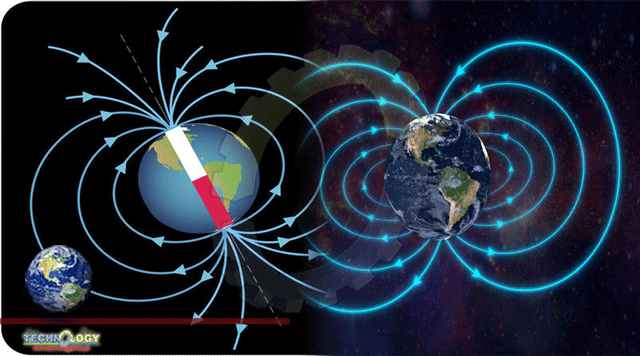New research shows that the magnetic field of our planet was relatively weak (less than half the strength of the long-term average field) for tens of millions of years between 332 and 416 million years ago; the similarities between this and a later period of low field strength provide further evidence for a 200- million-year-long cycle linked to deep Earth processes.

“Our findings, when considered alongside the existing datasets, supports the existence of an approximately 200-million-year long cycle in the strength of the Earth’s magnetic field related to deep Earth processes,” said Dr. Louise Hawkins, a researcher in the Geomagnetism Laboratory at the University of Liverpool and CGG Satellite Mapping.
“As almost all of our evidence for processes within the Earth’s interior is being constantly destroyed by plate tectonics, the preservation of this signal for deep inside the Earth is exceedingly valuable as one of the few constraints we have.”
In the study, Dr. Hawkins and her colleagues performed thermal and microwave paleomagnetic analysis on rock samples from two localities from the east coast of Scotland, United Kingdom.
They measured the strength of the geomagnetic field during key time periods with almost no pre-existing, reliable data.
They also analyzed the reliability of all of the measurements from samples from 200 to 500 million years ago, collected over the last 80 years.
The researchers found that between 332 and 416 million years ago, the so-called Mid-Palaeozoic Dipole low (MPDL) period, the strength of the geomagnetic field preserved in these rocks was less than quarter of what it is today.
It is similar to a previously identified period of low magnetic field strength that started around 120 million years ago.
The study supports the theory that the strength of the Earth’s magnetic field is cyclical, and weakens every 200 million years, an idea proposed by University of Liverpool’s Professor Andy Biggin and colleagues in 2012.
Deciphering variations in past geomagnetic field strength is important as it indicates changes in deep Earth processes over hundreds of millions of years and could provide clues as to how it might fluctuate, flip or reverse in the future.
A weak field also has implications for life on our planet. In 2020, University of Southampton’s Professor John Marshall and colleagues suggested that the Devonian-Carboniferous mass extinction is linked to elevated ultraviolet-B levels, around the same as the weakest field measurements from the MPDL.
“This comprehensive magnetic analysis of the Strathmore and Kinghorn lava flows was key for filling in the period leading up the Kiman Superchron, a period where the geomagnetic poles are stable and do not flip for about 50 million years,” Dr. Hawkins said.
“This dataset compliments other studies we have worked on over the last few years, alongside our colleagues in Moscow and Alberta, that fit between the ages of these two locations.”
“Our findings also provide further support that a weak magnetic field is associated with pole reversals, while the field is generally strong during a Superchron, which is important as it has proved nearly impossible to improve the reversal record prior to 300 million years ago.”
The findings appear in the Proceedings of the National Academy of Sciences.
Originally Published at Sci News